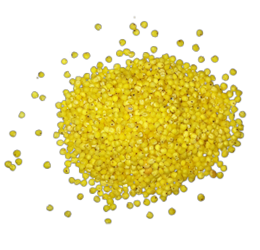|
Eating pearl
millet provides us with disease fighting phytochemicals that lower
cholesterol, antioxidants, plenty of fibre, folate, iron, magnesium, copper,
zinc, vitamins-E and B-complex, thiamine, riboflavin and niacin. It is a gluten
free grain. So it is one of the grains which can be easily included in the diet
of a person who is suffering from Gluten Induced Enteropathy or has allergy
towards gluten. It is noted for its high iron content also.
It has some
medicinal properties when bread is eaten with honey in the morning. It is
especially effective for bleeding piles, epilepsy, insomnia, impotency, high
blood pressure, diabetes and tuberculosis.
It is easily
digestible and has the lowest probability of causing allergic reactions.
Bajra, being
gluten free, is a very good food choice for those suffering from celiac disease
who cannot tolerate gluten.
It is highly
effective and recommended for cases of severe constipation and stomach ulcers.
The presence of
phytic acid and niacin in bajra helps in lowering the cholesterol.
Being rich in fibre
content, bajra is good for diabetics, keeping the glucose levels normal.
This whole grain
supports weight loss as the high fibre content leads to a feeling of fullness
for a prolonged period of time.
It is helpful in
maintaining cardiovascular health and in acidity problems.
Bajra helps in
reducing weight.
It controls blood
sugar levels and hence good for diabetic.
Excessive eating
of these grains causes high uric acid deposits in the system. So people with
kidney and rheumatic diseases should use it with care. As mentioned above,
Bajra comes with immense health benefits and uses. If you have known the
importance of whole grains, then you should make a conscious effort to include
Bajra in your diet.
Increase Your Heart
Health: Millet is one of the best possible grains to add to your diet if
you want to protect your heart, which is something that everyone can relate to.
Millet is a rich source of magnesium, which is an important mineral for
reducing blood pressure and the risk of heart attacks of strokes, particularly
in the case of atherosclerosis. Millet is also a great source of potassium,
which further keeps blood pressure low by acting as a vasodilator. Reducing
your blood pressure and optimizing your circulatory system is one of the best
ways to protect your cardiovascular health. Furthermore, the plant lignans
found in millet can be converted to animal lignans by the microflora in our
digestive system, and those animal lignans have been shown to protect against
certain chronic diseases, like cancer and heart disease.
Cholesterol Levels
in Check: Cholesterol levels go hand-in-hand with heart
health, so the high fibre levels in millet make for an ideal
cholesterol-lowering approach. Dietary fibre actually eliminates dangerous “bad
cholesterol” (LDL) from the system, while promoting the effects of “good
cholesterol (HDL).
Protection Against
Diabetes: Diabetes is a disease found in millions of
people around the world. Millet is a beneficial food staple in many developing
countries (where diabetes is less frequently found), perhaps because one of the
effects of millet is a reduced chance of Type 2 diabetes, thanks to the
significant levels of magnesium found in this particular grain. Magnesium is
considered one of the most important minerals for increasing the efficiency of
insulin and glucose receptors in the body, thereby preventing this disease. A
30% reduction in diabetes has been seen in populations divided between diets
with or without magnesium.
Digestive Health: As most fibre-rich foods boast, millet can help move your
gastrointestinal system along and eliminate problems like constipation, excess
gas, bloating, and cramping. By regulating your digestive process, you also
improve your nutrient retention and reduce your chance of more serious
gastrointestinal conditions like gastric ulcers or colon cancer. Regular
digestion and elimination of waste also helps to optimize your kidney, liver,
and immune system health, as those organ systems are closely related to the
body’s metabolic activities.
Cancer Risk: Recent research has revealed fibre to be one of the best and
easiest ways to prevent the onset of breast cancer in women. In fact, women can
reduce their chances of breast cancer by more than 50% by eating more than 30
grams of fibre every day. Given that breast cancer is one of the most common
and deadliest forms of cancer, this is advice that every woman should hear!
Detoxify the Body: Many of the antioxidants found in millet, in addition to their
beneficial impact on neutralizing free radicals, which can cause cancer, they
can also clean up other toxins from your body, such as those in your kidney and
liver. Quercetin, curcumin, elegiac acid, and various other beneficial
catechins can help to rid your system of any foreign agents and toxins by
promoting proper excretion and neutralizing enzymatic activity in those organs.
Respiratory System: Research has come to light showing that millet can significantly
improve the quality of life for people suffering from childhood asthma, and can
also prevent it from developing in the first place. Although some of the
evidence is controversial, it is shown that significantly less wheezing and
asthma attacks (by more than 15%) was seen in children who had large intakes of
grains like millet. However, as wheat is a common allergen that is associated
with asthma and wheezing, millet does not have the same components and does not
have this negative effect.
A Final Word of Caution: Given the modern stresses on our body, particularly to our
glandular system, the excessive work needed to properly digest and process
millet may be damaging. Consider speaking to your doctor about your glandular
and thyroid health before making a major shift to a millet-heavy diet.
|

